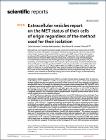| dc.contributor.author | Moran, Barry | |
| dc.contributor.author | O'Driscoll, Lorraine | |
| dc.date.accessioned | 2021-02-15T18:17:08Z | |
| dc.date.available | 2021-02-15T18:17:08Z | |
| dc.date.issued | 2020 | |
| dc.date.submitted | 2020 | en |
| dc.identifier.citation | Useckaite, Z., Mukhopadhya, A., Moran, B., O'Driscoll, L., Extracellular vesicles report on the MET status of their cells of origin regardless of the method used for their isolation., Scientific reports, 2020, 10, 1, 19020 | en |
| dc.identifier.issn | 2045-2322 | |
| dc.identifier.other | Y | |
| dc.identifier.uri | http://hdl.handle.net/2262/95141 | |
| dc.description | PUBLISHED | en |
| dc.description.abstract | MET pathway is an important actionable target across many solid tumour types and several MET inhibitors have been developed. Extracellular vesicles (EVs) are proposed to be mini-maps of their cells of origin. However, the potential of EVs to report on the MET status of their cells of origin is unknown. After applying three proposed methods of EV separation from medium conditioned by three cell lines of known MET status, this study used an extensive range of methodologies to fundamentally characterise the resulting particles (nanoparticle tracking analysis, TEM, flow cytometry, immunoblotting) and their MET status (RT-qPCR and ELISAs). The results indicated that ultracentrifugation on density-gradient (UC-DG) consistently produced the most reliable data with regards to purest EVs. EV cargo reflected MET mRNA, total MET and pMET status of their cells of origin. In conclusion, to simply determine if the general contents of conditioned medium reflect the MET status of the conditioning cells, choice of method for initial EV separation may not be crucial. However, to be confident of specifically studying EVs and thus EV-MET cargo, UC-DG followed by extensive EV characterisation is necessary. | en |
| dc.format.extent | 19020 | en |
| dc.language.iso | en | en |
| dc.relation.ispartofseries | Scientific reports; | |
| dc.relation.ispartofseries | 10; | |
| dc.relation.ispartofseries | 1; | |
| dc.rights | Y | en |
| dc.title | Extracellular vesicles report on the MET status of their cells of origin regardless of the method used for their isolation. | en |
| dc.type | Journal Article | en |
| dc.type.supercollection | scholarly_publications | en |
| dc.type.supercollection | refereed_publications | en |
| dc.identifier.peoplefinderurl | http://people.tcd.ie/lodrisc | |
| dc.identifier.peoplefinderurl | http://people.tcd.ie/moranba | |
| dc.identifier.rssinternalid | 222251 | |
| dc.identifier.doi | http://dx.doi.org/10.1038/s41598-020-75817-9 | |
| dc.rights.ecaccessrights | openAccess | |
| dc.subject.TCDTheme | Cancer | en |
| dc.subject.TCDTag | ADVANCED CANCER | en |
| dc.subject.TCDTag | Extracellular Vesicles | en |
| dc.subject.TCDTag | Extracellular vesicles (EVs) | en |
| dc.subject.TCDTag | LUNG CANCER | en |
| dc.subject.TCDTag | exosomes | en |
| dc.identifier.rssuri | https://pubmed.ncbi.nlm.nih.gov/33149187/ | |
| dc.identifier.orcid_id | 0000-0002-9860-8262 | |
| dc.subject.darat_thematic | Health | en |
| dc.status.accessible | N | en |
| dc.contributor.sponsor | Irish Research Council (IRC) | en |
| dc.contributor.sponsorGrantNumber | IRCLA/2019/49 | en |




